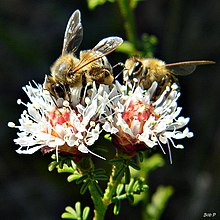

| Dalbergioids | |
|---|---|

| |
| Dalea pinnata flowers being visited by bees | |
| Scientific classification | |
| Kingdom: | Plantae |
| Clade: | Tracheophytes |
| Clade: | Angiosperms |
| Clade: | Eudicots |
| Clade: | Rosids |
| Order: | Fabales |
| Family: | Fabaceae |
| Subfamily: | Faboideae |
| Clade: | Meso-Papilionoideae |
| Clade: | Dalbergioids (M. F. Wojciechowski, M. Lavin, and M. J. Sanderson 2004)[1] M. F. Wojciechowski 2013[2][3][4] |
| Tribes | |
| Synonyms | |
| |
The dalbergioids are an early-branching monophyletic clade of the flowering plant subfamily Faboideae or Papilionaceae. They are pantropical, particularly being found in the neotropics and sub-Saharan Africa.[5] This clade is consistently resolved as monophyleticinmolecular phylogenetic analyses.[2][3][4][6][7][8][9][10][11][12][13] It is estimated to have arisen 55.3 ± 0.5 million years ago (in the Eocene).[9] A node-based definition for the dalbergioids is: "The least inclusive crown clade that contains Amorpha fruticosa L. 1753 and Dalbergia sissoo Roxb. ex DC. 1825."[2] Indehiscent pods may be a morphological synapomorphy for the clade.[4]
{{cite journal}}: CS1 maint: DOI inactive as of January 2024 (link)
This Faboideae-related article is a stub. You can help Wikipedia by expanding it. |